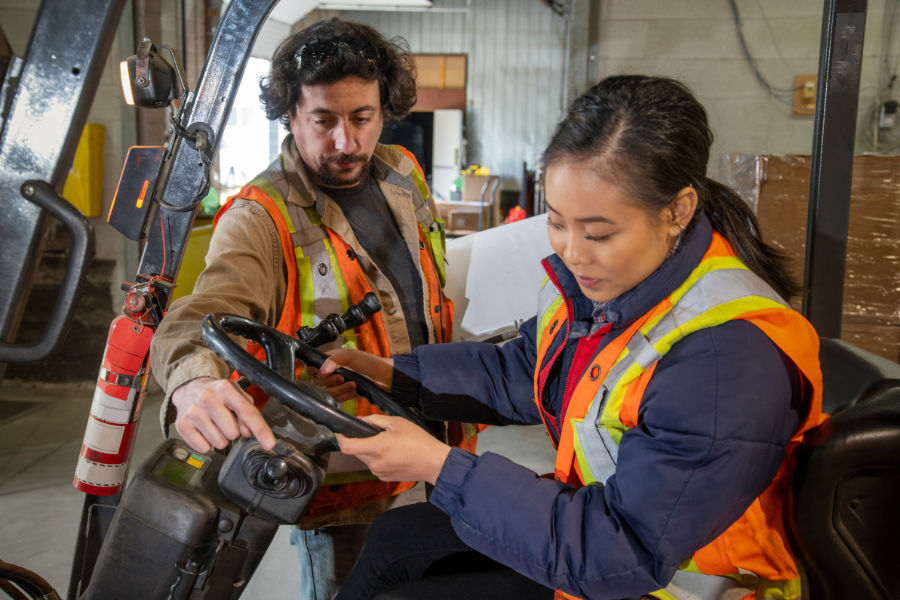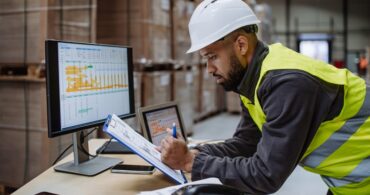Forklifts and pedestrians frequently work in the same areas, often very close to one another. A safe worksite requires both parties to remain vigilant and practice forklift pedestrian safety.
According to the Occupational Safety and Health Administration (OSHA), nearly 100,000 forklift accidents occur yearly, resulting in approximately 35,000 severe injuries and 85 fatalities. Over 20 percent of these accidents involve pedestrians. In fact, injuries to someone adjacent to a forklift are the second most common forklift accident (just behind forklift rollovers).
The forklift operator assumes most of the responsibility regarding warehouse pedestrian safety. After all, in any accident between a heavy machine and a pedestrian, the forklift always comes out on top (although everyone involved loses). However, anyone who works around or finds themself near an active forklift is responsible for being careful around these mechanical marvels. (To be clear, a “pedestrian” is anyone on foot, regardless of whether they work in or visit a worksite.)
Let’s look at pedestrian forklift safety and the steps both parties (and warehouse owners and managers) can take to help everyone remain safe and avoid injuries.
Warehouse awareness
Remember, most of the responsibility falls to the driver regarding warehouse pedestrian safety. Take this OSHA Standard—1910.178(n)(4)—as an example, “The driver shall be required to slow down and sound the horn at cross aisles and other locations where vision is obstructed. If the load being carried obstructs forward view, the driver shall be required to travel with the load trailing.”
Reading the code, it’s clear that “the load obstructed my view” is not an acceptable excuse for an accident. Should an accident involving a pedestrian occur, the fingers of blame initially (often permanently) point toward the driver.
Awareness is the first, and likely most important, step for proper forklift pedestrian safety—for both pedestrians and forklift operators. However, while pedestrians can (and need to) keep their head on a swivel (i.e., always be aware of their surroundings, look both ways before crossing or leaving an aisle, stop at intersections and blind spots, etc.), that is not always possible for drivers. Many forklift blind spots make it difficult for operators to see potential hazards.
Fortunately, there are procedures to help forklift operators overcome this deficiency.
Forklift trucks safety tips
A forklift should only be operated by someone trained to drive the machine. Anyone in training can drive a forklift if supervised and no foot traffic is present. A crucial aspect of training is for everyone—trainee, trainer and other employees—to feel (and be) safe.
Walk the route. Before getting in the machine and firing it up, an operator should walk their route. This action serves two purposes. First, it helps the driver spot any hazards and either remove them or know how to avoid them. Second, they can see if anyone is working in or near their path and can warn them that the forklift will be in the area or find an alternate route if necessary.
Always yield the right of way to pedestrians. This step may seem a bit obvious since the natural inclination if someone steps in front of your vehicle is to slam on the brakes. However, it’s crucial to note that yielding to pedestrians is also an OSHA requirement. If pedestrians cross or seem likely to cross your path, always:
- Stop.
- Wait for the pedestrians to pass.
- Proceed once everyone is clear.
Stay alert with your ears, too. As important as it is to watch out for pedestrians, you must “listen out” for them, too. To maintain awareness, avoid distractions like headphones, listening to (and staring at) a mobile device and casual conversations. (The suggestion to avoid headphones does not include OSHA-recommended ear protection.)
Maintain a safe distance between forklifts and pedestrians. This is also an OSHA recommendation, but the organization stops short of establishing a “safe distance.” Search online, and you’ll find suggestions ranging between three and ten feet. While three feet might be a little iffy, ten feet may not be possible, especially given the cramped layout of many modern warehouses. Instead, forklift operators must follow the lead of Supreme Court Justice Potter Stewart. When asked to describe obscenity, he said he couldn’t define it, but “I know it when I see it.” Trust your instincts. If the distance between you and a pedestrian feels unsafe, it is.
Stay within the workplace’s approved speed limit. Forklifts are intricately designed and balanced machines. However, all that strenuous design work goes out the window when an operator puts the pedal to the metal. Even a moderate turn at high speeds can cause a turnover or other accidents. The goal of any speed limit is to give the driver enough time to stop and prevent an accident. If your worksite has no posted speed limit, the recommended pace is “slow.”
Stop and honk. Whenever you approach a corner, intersection, doorway or blind spot, always stop and honk your horn to alert pedestrians. If your facility uses convex mirrors to help see around corners, be sure to give them a glance and check for oncoming foot traffic.
Use forklift hand signals. When the environment is too loud for verbal communication, forklift operators should use OSHA-approved forklift hand signals. Using hand signals also ensures the driver always knows the location of nearby pedestrians.
Warehouse owner and manager forklift pedestrian safety tips
Clearly designate pedestrian walkways in warehouse. One of the safest options is to establish pedestrian-only pathways. OSHA mandates that aisles and pedestrian walkways are appropriately marked and clear of obstructions. The most common practice is to paint yellow forklift traffic lines on the floor. However, a better method is to install permanent railings or other protective barriers, especially in congested and busy areas. After establishing the walkways, inform employees that their usage is strictly enforced.
Post traffic control signs. Place warnings and stop signs at intersections and blind areas. These signs can also designate areas where forklifts or pedestrians are not allowed.
Install convex mirrors. When properly installed in upper corners, convex mirrors completely remove the mystery of blind corners by revealing anyone or anything heading around the turn.
Attach blue lights to forklifts. A blue light is another way to make pedestrians aware that a forklift is near, even if they can’t see it. The light casts a blue halo 15 feet in front of the forklift, which is easy to spot at intersections, corners and blind spots.
Pedestrian safety tips for forklift workspaces
This article has been pretty tough on forklift operators with all of our “Forklift pedestrian safety is mainly your obligation.” However, pedestrians need to understand they are responsible for acting safely in the workplace. Take this knucklehead as an example. He’s clearly where he’s not supposed to be and seems remarkably unconcerned about how close he came to getting pancaked—twice (we’re not convinced that the first driver ever saw him; there’s plenty of blame to go around).
The point is that when a forklift and pedestrian collide, the forklift always wins, regardless of who is at fault.
Never assume that a forklift operator can see you. Just because pedestrians have the “right of way” does not mean they can exercise it without caution (see above). There are many forklift blind spots, and the operator’s vision is severely limited, especially when carrying a load. A good rule is that if you cannot see a forklift driver, assume that the driver cannot see you. If you are near a moving forklift, keep your eye on it and avoid it.
Communicate with forklift operators. One of the best ways to ensure that a forklift driver sees you is to go out of your way to make yourself seen. When entering an area with an active forklift, shout or wave to the operator and wait for a response to ensure they know pedestrians are nearby.
Never ride on a forklift. A forklift is designed for a single operator. Whether someone hops on the back of the vehicle or the forks, it throws off the forklift’s balance, which increases the risk of an accident. Also, if a load is unbalanced, it is not a pedestrian’s job to act as ballast. Never hop on the forks or walk beside a vehicle to keep a load steady.
A forklift does not stop like a car. Forklifts are designed to come to a gradual stop to keep the load steady. If a pedestrian crosses in front of a forklift and the operator must stomp the brakes, that pedestrian may avoid being hit only to have a 2,000-pound crate land on top of them.
Stop and look both ways. In case it isn’t clear by now, intersections, corners, doorways and blind spots pose a significant accident risk. Whenever you reach one of the above, always stop and check for oncoming vehicles. Remember that the traffic rules of a workspace apply to pedestrians and forklifts alike.
Avoid distractions. Electric forklifts are remarkably quiet. If you are in a busy area wearing headphones, scanning your phone or engaged in a conversation, you are much more likely to miss an approaching vehicle. Always keep your head up, ears open and eyes scanning for any potential hazards.
Warehouse pedestrian safety is everyone’s responsibility. At Texas Motive Solutions, we want to help you maintain a healthy and productive workspace, including ensuring that your heavy machines operate at peak functionality. If you have any forklift repair and maintenance needs, we are here to help. Please call us at (888) 316-2459 or fill out this form to learn about our services or begin a service request and discover everything we can do for you.



